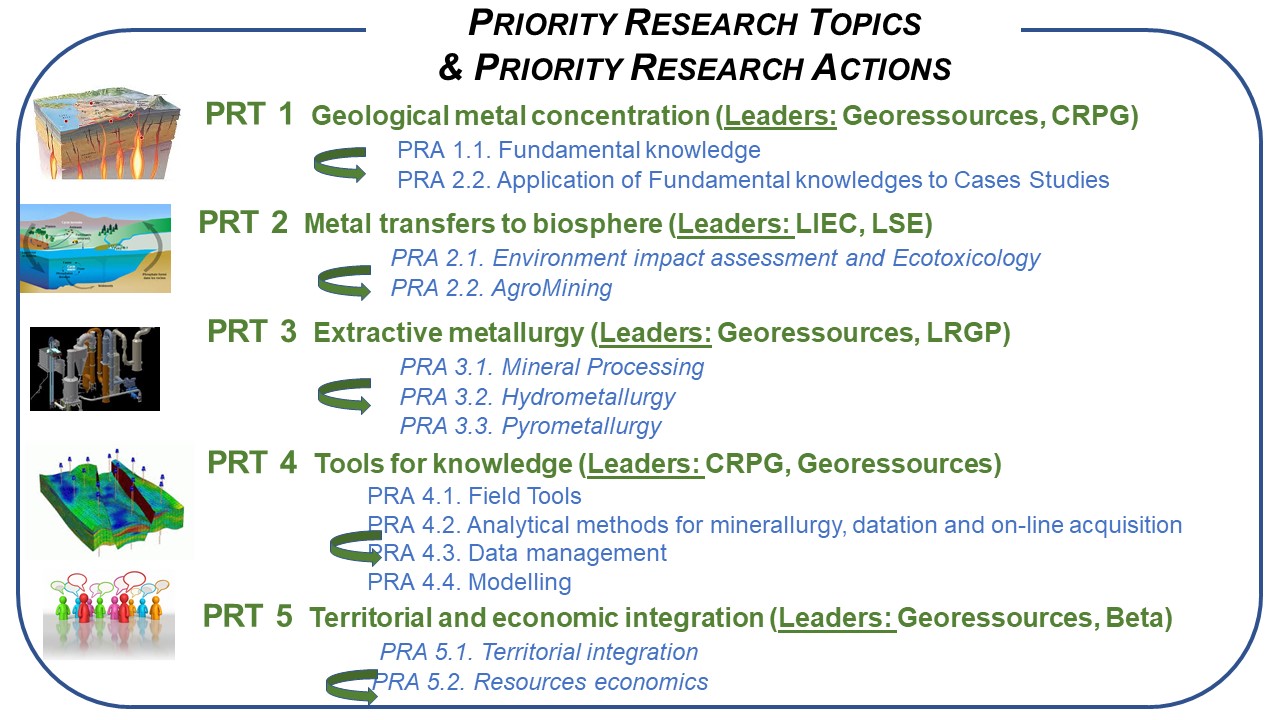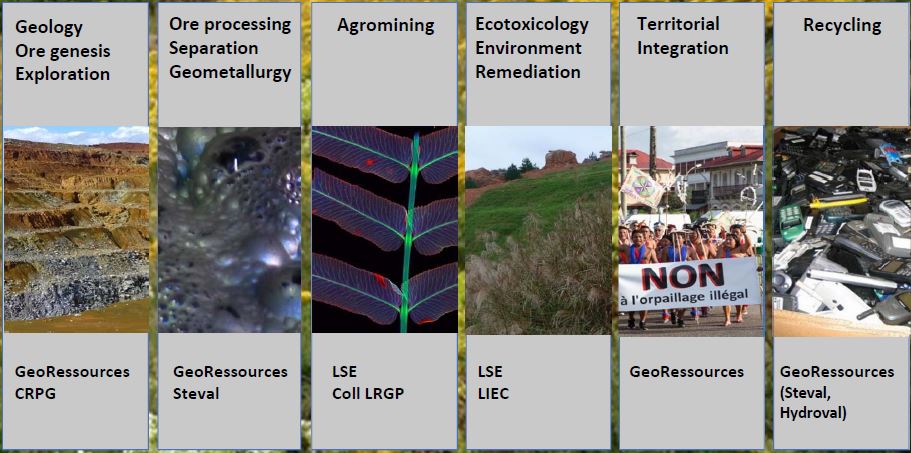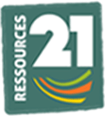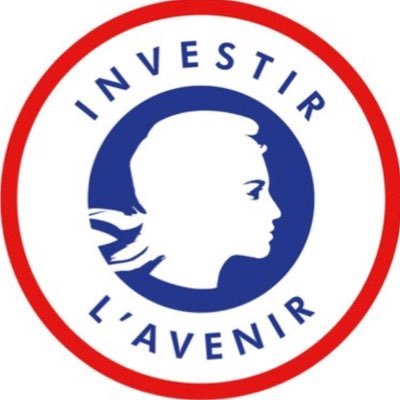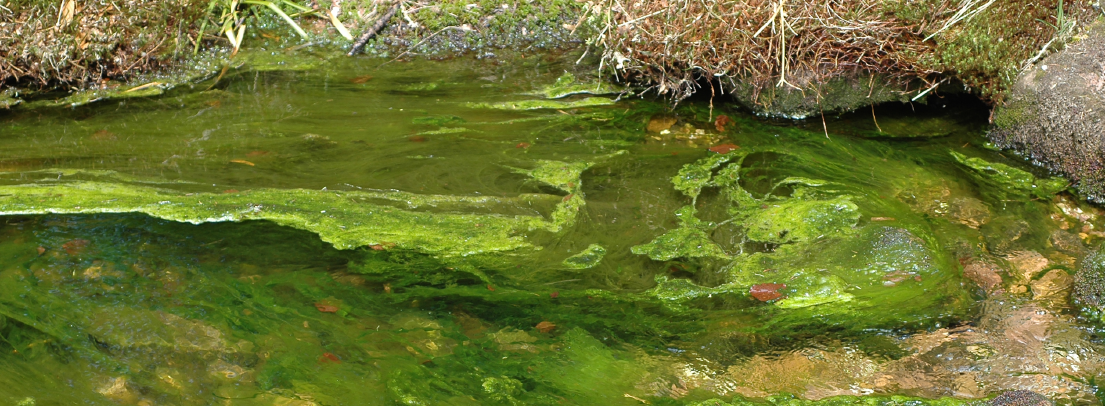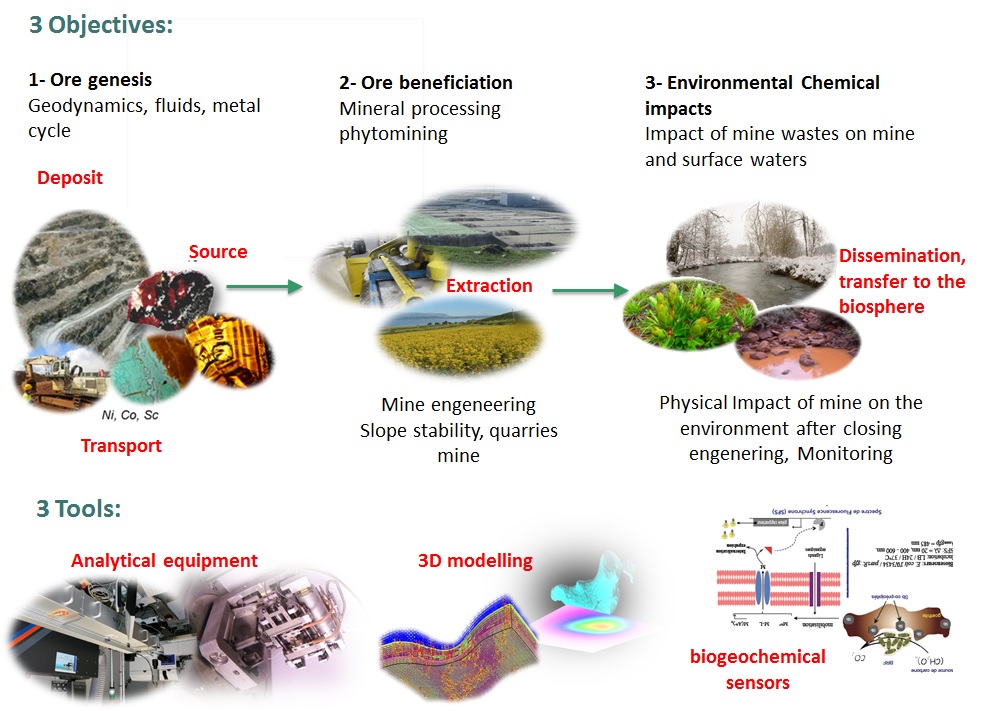The scientific activities of the “Strategic Metal Resources in the 21st Century-RESSOURCES21” Laboratory of Excellence focus on the following priority areas
PRT 1: Geological metal concentration processes
This PRT will focus its activity on a better understanding of the processes responsible for metal concentration with an application with the case studies included in the Transversal Targets. Kinetics of melting and crystallization processes, especially in felsic rocks (rare metal granites for instance) as well as metal fractionation between mineral phases and/ or mineral/ fluid phases will be addressed in this PRT in close interaction with PRT4. In situ metal distribution in ores and minerals and metal concentrations in paleofluids ((in situ analysis of fluid inclusions by LA-ICP-MS) will be developed thanks to analytical means set up during the first step of the labex. These data are both useful for ore genetic process reconstructions and geometallurgical approach (PRT3). The development of new dating methods which allow to rely ore processes to geodynamics complete finally the fundamental understanding of the mineral systems involved in the formation of natural metal concentrations.
PRT 2: Metal transfer to and into the biosphere – Environmental impact assessment and Ecotoxicology
This PRT will focus on metal transfer to biosphere and their ecotoxicology and metal transfer from soils to hyperaccumulator plants for agromining purposes. The approach for the investigation of metal transfer to biosphere will consist in building a complete database on the ecotoxicity of gold as well as the associated metals arising from mining activities (As, Te, Bi, Ni-Co), and lithium (and other elements from brines such as F, Br, Cl, B …) as it was implemented in the previous years for nickel and has started to be investigated for rare-earth elements. More especially, it is interesting to highlight the lack of knowledge about lithium toxicity and the potential increase of its toxicity in the presence of other elements that potentially exist in brines, geothermal sources or ores (multi-stress or multi-contamination processes with multiple and possible crossed effects on living organisms and on the trophic chain). More generally, ecotoxicological studies previously conducted within the framework of the Labex R21 have mainly been carried out on aquatic environments (only few tests were carried out on soils) and other studies have been conducted on soils to investigate the transfer of REEs towards plants and micro-organisms. In the present project, this PRT will consider the transfer between the terrestrial and aquatic environments, which could benefit from the devices acquired at LIEC (Ecoscope) and the experimental platform of GISFI and the expertise of LIEC and LSE. For fulfilling these goals, it will be necessary to work on the modelling of the continuum from the molecules to the different compartments of the trophic chain, in strong interaction with PRT4 for the physicochemical and geochemical modelling of transfers from soil to organisms, and to enable developments of efficient sensors so as to feed the created models with accurate data.
Regarding agromining, basic research will be conducted to obtain knowledge about plants able to accumulate metals of interest. The development of appropriate soil conditions to improve metal extraction by hyperaccumulator plants under hard conditions, and the understanding of the associated phenomena responsible for metal transfers will be investigated in this PRT. This work will rely on the expertise recognized at the international level of UL in regards to the last development funded by Labex R21 demonstrated by the great number of publications (63 papers since 2012), the leadership in two European projects and the international visibility strengthen by international collaboration with several countries (China, Australia, Albania) and the creation of an two international laboratories with China (LIA) and Australia (University of Queensland).This knowledge will be very useful to develop efficient bioremediation processes and extraction processes based on hydrometallurgical routes, in close interaction with PRT3 for the valorisation of metals issued from ores and residues produced by mining activities. The originality of this approach arises from the unique transversal and complete research activities relying on soil science, agronomy and hydrometallurgy that leads to interesting development in fundamental science and industrial application (creation of the start-up Econick). This successful approach will be obviously strengthened within the present project of extension of the labex R21 with the help of the PRT3 and the use of the recent facilities in hydrometallurgy funded recently by the Labex R21 (laboratory of hydrometallurgy HydroLAB and mini-pilot facilities in hydrometallurgy HydroVAL).
PRT 3: Extractive metallurgy
The Labex R21 will continue intensifying its activities in fundamental and applied researches for the development of efficient environmentally friendly processes to recover metals from complex and polymetallic ores, and spent materials containing the transversal targets, namely nickel, rare earth elements, gold and lithium. In particular, this PRT will try to address the following questions: (i) Which approaches need to be developed to get a breakthrough in processing technology for the future resources (intensive processing technology, new reagent and equipment design, etc.)? (ii) How to develop and implement predictive models in a global geometallurgical approach of the resource exploitation (Thermodynamics, DFT and force field modeling, QSPR models, automated optimization, artificial intelligence, etc.)? and (iii) Which approaches are the more significant and how to unlock “urban mining” to secure the supply of strategic materials?
This PRT3 will rely on the expertise of GeoRessources, LRGP and Institut Jean Lamour in the fields of mineral processing, hydrometallurgy and pyrometallurgy. The STEVAL platform capable to reproduce each operation of extraction metallurgy processes (crushing, physical separation, leaching, purification) will be an asset to develop processes at high TRL. Strong interactions with PRT1 for raw material characterization, PRT2 for environmental impacts of the processes and more especially the development of valorisation processes of materials produced by agromining, PR4 for on-line analyses and modelling tools as well as PRT5 will be implemented in the projects.
PRT 4: Tools for knowledge
This PRT is focused on the development of analytical methods and sensors to improve the knowledge in (i) geosciences in order to better characterize and identify new ores and to understand the phenomena involved in metal concentration, (ii) environmental sciences and biology to better describe the phenomena involved in metal mobility and transfer in the ecosystems and their impacts on organosms (ecotoxicology) and their recovery using non-conventional mining process (agromining), and (iii) to develop on-line analytical tools for improving process control. The development of modeling tools and data management will be also at the center of this PRT. Therefore, this PRT is by nature cross-cutting to the other PRTs since most of them depend on the development of relevant and accurate tools and methods. In particular, the development of geophysical tools such as drones and surface (field) geophysical tools will be part of this PRT as well as the development of geochemical monitoring and sampling tools with relevant sampling strategies. A great effort will be put on building numerical models for metallogenic systems, in particular coupled reactive transfer models, geometallurgical approaches that could integrate all the information available on ores’ mineralogy, grades and metallurgical variability within spatially-based predictive models, and modelling and numerical assessment of mining extraction. Interactions between metals and ecosystems will be studied and modeled and tools to assess the potential impacts on mining processes on the functioning of ecosystems and on biodiversity.
PRT 5: Territorial and Economic integration
Mining projects are not conventional industrial projects since, in addition to their increasing technical complexity, they must integrate a sensitive social dimension and related geopolitical aspects that will influence the market prices, inevitably contributing to the uncertainty of the projects. A multi-disciplinary approach that includes a place for human and social sciences, resource economics and innovation management in addition to all technical aspects has an essential place within the Labex R21 project, and will lead to an original systemic approach while contributing to the excellence and recognition of LUE at national and international levels. Regarding the territorial integration aspects, the efforts initiated during the last two years of the Labex will continue. In particular we will focus on the impacts of mines on the territory (impacts, perception feedback experience, remediation), enlarging the understanding of the mechanisms involved in controversies and debates (contents of debates, modalites of consultation, access to information) as well as the regulatory framework and governance (mining code, environmental laws). With regard to resource economy, we will focus our efforts on the management and economic processes of innovation in order to investigate the economic and social mechanisms upstream, influencing the acceptance and the diffusion of discoveries related to Labex projects as well as their commercial sustainability. We will also work on preventing ecological and financial damages by studying the trade-off between innovation and risk. In particular, research will be conducted to analyse how legal frameworks impact decisions in terms of risk prevention and innovation processes. It is obvious that these economic approaches will significantly contribute to the transversal targets of Labex, by implementing original studies in environmental, economic and social impacts of nickel, rare earth elements, gold and lithium exploitations.
Transversal targets (integrated program)
The knowledge, tools and concepts developed in the PRTs will be applied to transversal targets, i.e. nickel (New Caledonia, Malaisia, Albania), rare-earth elements (China, Canada), gold (French Guiana) and lithium (France, Chile, Australia, Spain and Portugal). A particular attention will be paid to develop collaborations on these topics with French and European companies interested by these transversal targets (primary and secondary resources). Research activities on nickel and rare-earth elements will be in line with the previous research program of the Labex R21 as described in the earlier/first part of this document. For the next 4-yearproject, gold and lithium have been chosen because of their economic and strategic importance and because it is essential to study thoroughly the geochemical cycle of these elements as well as the socio-economic and ecological impacts of mining in order to ensure the success of gold and lithium exploitation and the development of sustainable and efficient extraction processes.
